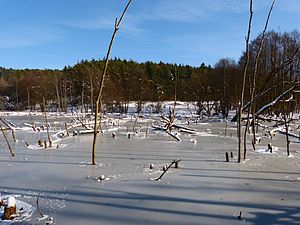Grubenfelder Leonie nature reserve
|
Mine fields Leonie
|
||
|
Pond in the nature reserve |
||
| location | Auerbach in the Upper Palatinate | |
| surface | 17.65 | |
| Identifier | NSG-00513.01 | |
| WDPA ID | 163390 | |
| Geographical location | 49 ° 42 ' N , 11 ° 38' E | |
|
|
||
| Setup date | 1996 | |
The nature reserve Grubenfelder Leonie is located in the districts of Auerbach, Degelsdorf, Steinamwasser and Zogenreuth, north of the urban area of Auerbach in the Upper Palatinate in the district of Amberg-Sulzbach . The area covers 87.3 hectares of forest and open land and is home to around 570 animal and plant species, over 100 of which are on Bavaria's Red List.
history
Iron ore was mined underground on the site until the 1980s . The collapse of the resulting cavities created depressions and faults. The name of the reserve goes back to the name of the ore mine. In 1995, the State Association for Bird Protection in Bavaria acquired a large part of the area that has been under nature protection since 1996 .
Wildlife
In addition to the Heck cattle and the Exmoor horses, various wild mammals live on the area, including beavers, brown hares, red foxes, badgers and deer. Among the 64 breeding bird species, the corncrake , red-backed shrimp and kingfisher should be mentioned. The regular guest bird species include white storks, black storks, whinchat, wheatear, great gray shrike and little ringed plover. One of the largest tree frog populations in the Upper Palatinate still lives on the site . There are also yellow-bellied toads , crested newts and six other amphibian species. Reptiles are represented by four species, including the grass snake , which is considered endangered . Among the invertebrates, 22 dragonfly species, 54 day butterfly species, 23 grasshopper species and 18 ant species were recorded.
Maintenance and development measures

In order to keep the meadows open and to protect them from reforestation, the area has been grazed by Heck cattle (breeding images of the aurochs) since June 2000 . The Przewalski horses, which have also grazed there since 2001, have now been replaced by the primitive Exmoor horses .





